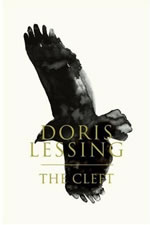
In the beginning, there were only women. Then one day, a deformed baby with a tube hanging in front was born. These deformed babies grew up with breasts that have no milk inside and nipples that were dysfunctional …
The above is how the plot begins in “The Cleft”. I don’t know how you all make decision in picking up a book to read. Here was what went through my mind chronically when I picked up “The Cleft”.
- Cool title with a nice cover – 5% of importance
- Nobel Price winner in literature sticker – 30%
- Unusual plot of in the beginning, there were only female species – 40%
- Under 300 pages – 10%
- Writing style that is easy to read – 15%
In fact, “The Cleft” has all the right ingredients that I was so tempted to buy the book at first sight, at second sight. But these days, I want to see return from my own tax money. I borrow from the library instead.
To fully appreciate “The Cleft”, you really have to drop all that you know about the two sexes and start over. Presumptions will only frustrate you and you may probably miss what “The Cleft” is about: an evolution of human society from single sex sea creatures (in human form) that have no conception of the collective “we” and the individual “I” to the interdependency of the two sexes that realize “how few we are, how easily we die” (a direct quote). The journey from the primordial life form to the realization of moral righteousness, the importance of the continuation of the species, the never ending yearning of exploration, and the discovery of love is not an easy journey to cover in fewer than 300 pages.
And that is only half of what “The Cleft” is about. The main story – that only account for a tiny portion of the book – centers around an old Roman senator who was tasked to write a history on the first recorded human society. Seeing how history was written in “The Cleft” makes me reflect upon how our own history is written. Legends are passed onto generations orally in forms of memories, and stories. Somehow, the first half of the book – the early era of the clefts (female species are being referred as “the clefts” while the male species are referred as “the monsters” by the clefts and as “the squirts” amongst the men) – reminds me of the biblical story of Adam and Eve, equally mythical and ancient.
One day, a boy was born amongst the clefts and the clefts had decided to feed the “deformed” baby to the Great Eagles at the Killing Rock. Soon, more and more boys – or “monsters” in their jargon – were born and instead of killing the boys, the Great Eagles took them away from the caves of the clefts and into the valley. There, the monsters or rather the squirts – a preferred term amongst the male species – established themselves as a society relying on the Great Eagles to deliver them the babies. The early era of the clefts is definitely a great read on its own.
Superimpose onto this fable is the old Roman senator taking in a beautiful young wife who was sexually active amongst her own social circle. Back in the days of the Roman Empire, or even to the days of the Cleft when clefts and squirts participated in mass procreation exercise, what social norms were there to judge the orgies and gladiators? There was probably none. That is the hat you may wish to wear when you read “The Cleft”. And that is probably why Doris Lessing is a genius – shifting a rather simple fable from our modern day mindset into a perspective of an ancient Roman making the idea so original.
Over time, songs were written (like my favorite title: “how few we are, how easily we die”) and onto the second era, the clefts and the squirts further interacted, procreated, disagreed, and fought. The fundamental differences between the two sexes began to emerge. The harsh external environment made them realized how fragile life was, how precious babies were. The notion of love and leadership began to emerge too. This later era of the clefts may not be as magical as the one before making it a less interesting read. But I guess the rather beautiful and abrupt ending makes up for it. Till today, I am still trying to decipher what to make out of the ending. I was like so close to the Cleft civilization one moment in time and all of a sudden, I was thrown back to my own reality. The visualization of the Cleft civilization literally faded away in front of my own eyes.
On a side note, it is coincidental that the author of this book (88 years of age) and the author and director of “Persepolis” from my previous blog are both born in the same place – Persia or Iran, depending which year you are referring to. Doris Lessing’s parents were both British and she has won every single European literature award. I wish I could recommend a more renowned literature from her collection of 50 books but this rather controversial piece of artwork is all that I have read from her.
Related Entries:-
- The Cleft By Doris Lessing – Drop All That You Know And Start Over
- Mara And Dann By Doris Lessing – An Adventure Of A Sister And A Brother During The Next Ice Age
- Doris Lessing – The Story Of General Dann And Mara’s Daughter, Griot And The Snow Dog
- The Fifth Child By Doris Lessing – Horror Or Tragedy? You Decide
- Ben In The World By Doris Lessing – Sympathetic Love And Desperation Mashed Into One